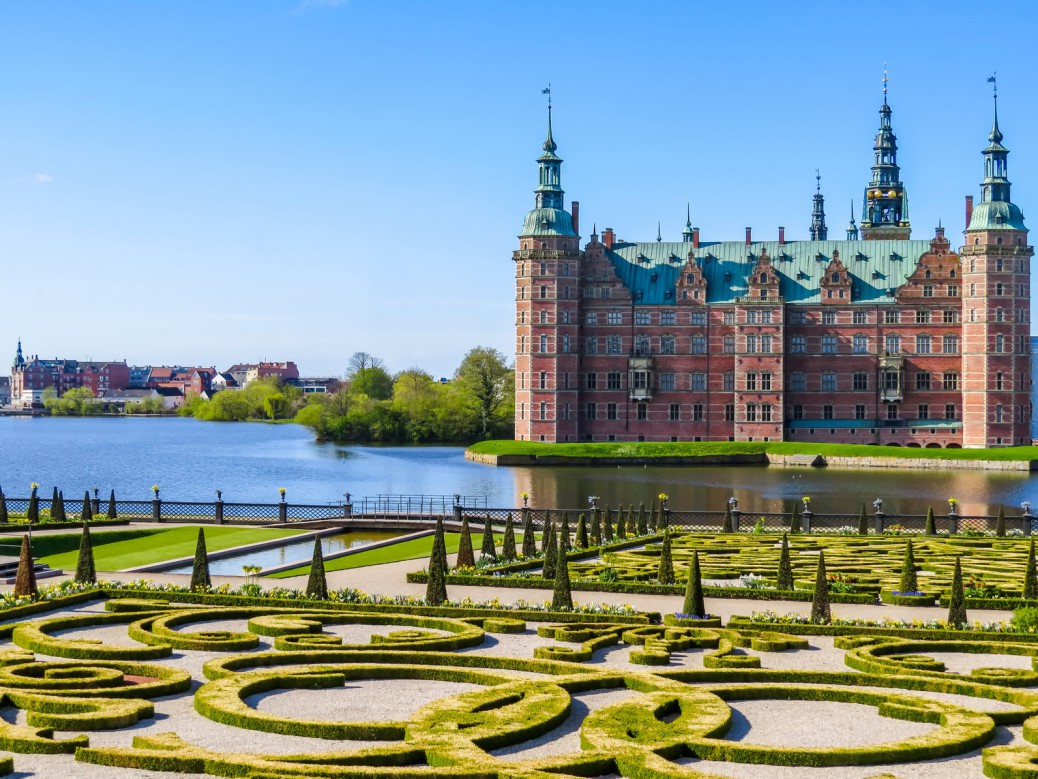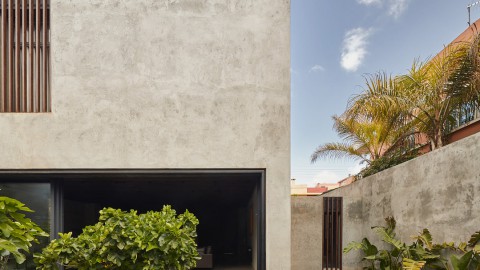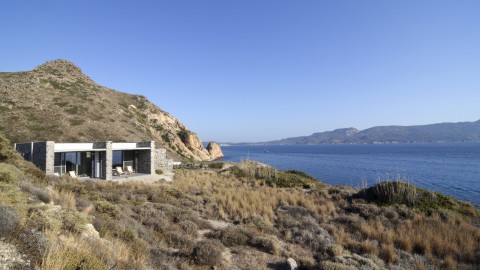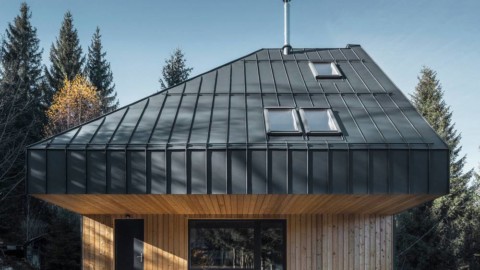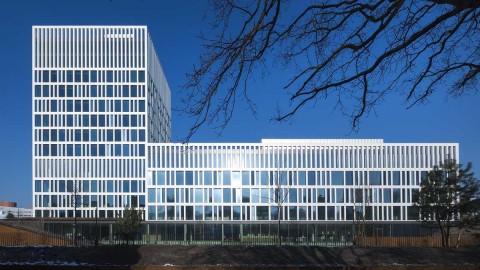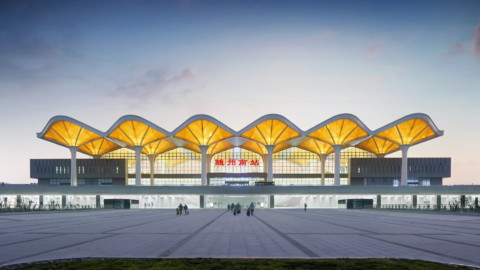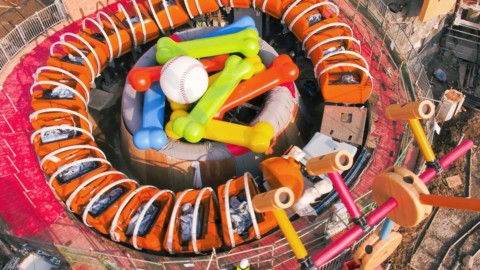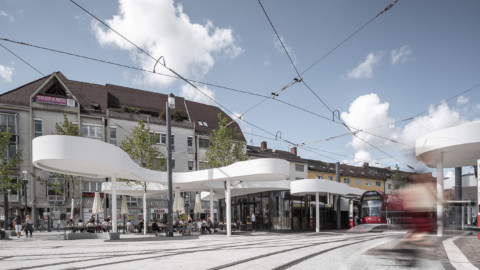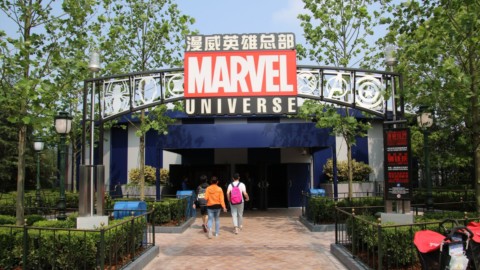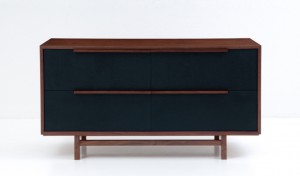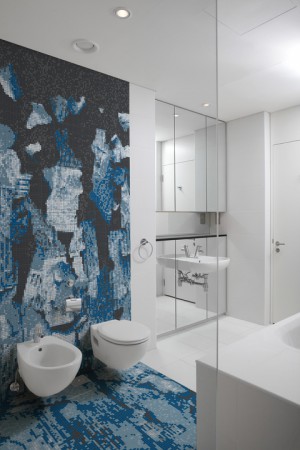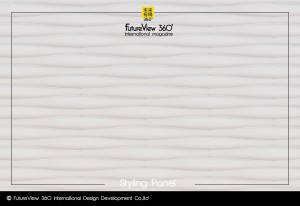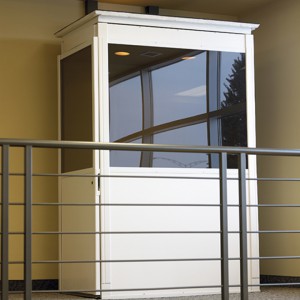Frederiksborg Castle 腓特烈堡城堡
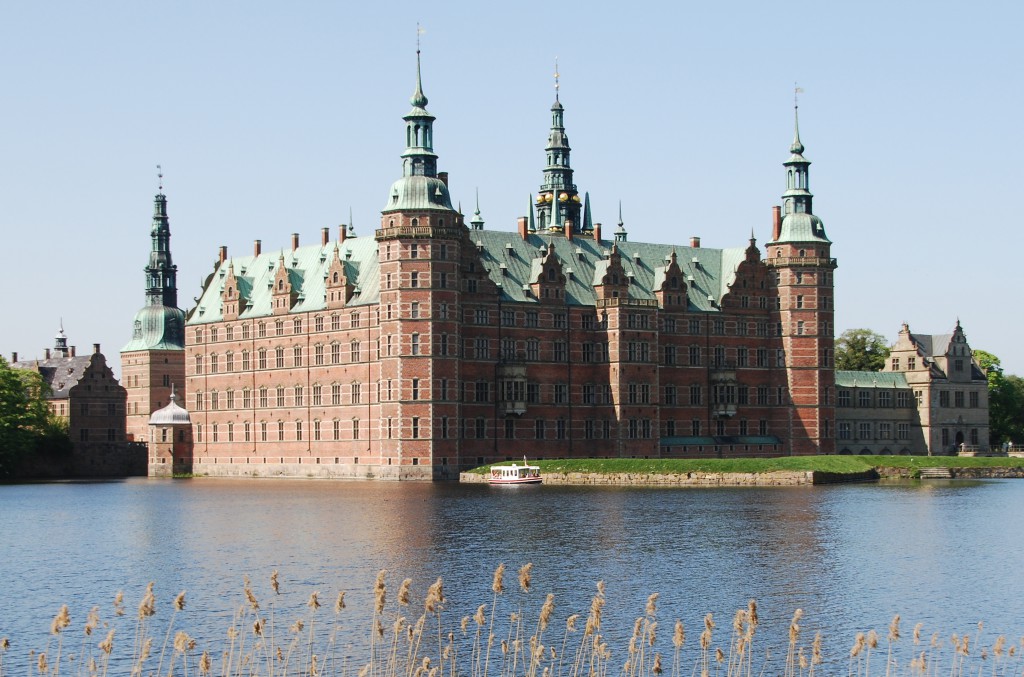
Frederiksborg Castle (Danish: Frederiksborg Slot) is a palatial complex in Hillerød, Denmark. It was built as a royal residence for King Christian IV of Denmark-Norway in the early 17th century, replacing an older castle acquired by Frederick II and becoming the largest Renaissance residence in Scandinavia. Situated on three islets in the Slotssøen (castle lake), it is adjoined by a large formal garden in the Baroque style.
After a serious fire in 1859, the castle was rebuilt on the basis of old plans and paintings. Thanks to public support and the brewer J. C. Jacobsen, the building and its apartments were fully restored by 1882 when it was reopened to the public as the Danish Museum of National History. Open throughout the year, the museum contains the largest collection of portrait paintings in Denmark. It also provides visitors with an opportunity to visit several of the castle’s state rooms including the restored Valdemar Room and Great Hall as well as the Chapel and the Audience Chamber which were both largely spared by the fire and contain sumptuous decorations.
Frederiksborg城堡(丹麥語:Frederiksborg Slot)是丹麥Hillerød的一座富麗堂皇的建築群。它建於17世紀初,是丹麥 – 挪威國王克里斯蒂安四世的皇家住所,取代了弗雷德里克二世收購的舊城堡,成為斯堪的納維亞半島最大的文藝復興時期住宅。酒店位於Slotssøen(城堡湖)的三個小島上,毗鄰巴洛克風格的大型正式花園。
在1859年嚴重火災之後,城堡在舊計劃和繪畫的基礎上重建。得益於公眾支持和釀酒商J. C. Jacobsen,該建築及其公寓於1882年完全修復,當時它作為丹麥國家歷史博物館重新向公眾開放。博物館全年開放,收藏了丹麥最大的肖像畫集。它還為遊客提供了參觀城堡的幾個國家房間的機會,包括經過修復的Valdemar房間和大廳以及教堂和觀眾廳,這些房間都很大程度上不受火災的影響,並且裝飾著華麗的裝飾。
General information
Use (s): Museum
Renaissance style
Cataloging: monument on Kulturstyrelsen register
Location: Hillerød, Flag of Denmark Denmark
Coordinates: 55 ° 56’06 “N 12 ° 18’03” ECoordinates: 55 ° 56’06 “N 12 ° 18’03” E (map)
Date of construction: 1560-1630
Owner: Cristián IV from Denmark
Design and construction
Architect (s): Hans van Steenwinckel the Elder
一般信息
使用:博物館
風格:文藝復興
編目:Kulturstyrelsen登記冊上的紀念碑
地點:Hillerød,丹麥國旗丹麥
坐標:55°56’06“N 12°18’03”ECoordinates:55°56’06“N 12°18’03”E(地圖)
施工日期:1560-1630
所有者:來自丹麥的CristiánIV
設計和施工
建築師:Hans van Steenwinckel the Elder
Architecture
In line with Flemish and Dutch Renaissance tradition, the quadrangular castle covering the entire area of the northern islet is built of red brick with stepped gables, towering spires and light sandstone decorations. The symmetry of the main structure is broken by the large bell tower on the Chapel Wing. All three wings are fundamentally independent buildings which have been joined together to form a complex. The usual concern with symmetry was overridden by the need to glorify Christian IV with sculptural decorations evoking astrology and mythology as can be seen in the gate house, the Terrace Wing and the Neptune Fountain. The window gables also display statues of historic emperors including Alexander the Great and Julius Caesar.
The King’s Wing, the main wing of the Renaissance building, was completed in 1604, the Chapel Wing followed in 1606 and the Princess’s Wing on the eastern side in 1608. All three were three storeys high but the Terrace Wing, completed in 1609, had only one storey. The side of the Terrace Wing next to the moat was decorated with mythological figures while open arcades overlooked the courtyard. The central portal bears the arms of King Christian and Queen Anne Catherine and its completion date, 1609.
The castle is noted for its towers and turrets. All the outer corners are decorated with towers. Two octagonal towers with lofty spires overlook the lake (Mønttårnet to the west and Jægerbakkettårnet to the east) and two round one-storey towers face the central islet. Stair turrets with copper-clad domes decorate the courtyard side of the King’s Wing. The highest and most impressive tower stands above the Chapel. The chamfered corners of its multistorey spire are decorated with four obelisks.
The Audience House (Audienshuset) was completed in 1616. With its swinging gables and protruding bay windows in the Renaissance style, the elegant five-wing building on the middle islet over the moat from the Mønttårn tower on the main building. Its south-facing portal, Møntporten, decorated with figures including Venus and Mars surrounded by musicians, is considered to be one of Denmark’s finest. In 1621, Christian IV decorated the King’s Wing with the Great Gallery overlooking the courtyard. The statues of the gods, decorating the two storeys, were crafted by Hans van Steenwinckel the Younger in Amsterdam and brought to Denmark by ship.
The middle islet was further developed during the reign of Christian IV. The lord lieutenant’s manor (Slotsherrens Hus) to the west was completed in 1611. The Chancellery to the east was erected in 1615 as a true copy of Berritsgård on the island of Lolland, one of the finest Renaissance buildings in Denmark. Both buildings were decorated with an octagonal turret and sweeping gables.
While most of the castle was destroyed by fire in 1859, the Chapel and its furnishings suffered only minor damage. The Chapel has also been used as the ceremonial chapel for the Order of the Elephant and the Order of the Dannebrog since 1693. It houses the Danish royal family’s art collection, notably works on the life of Jesus by the Danish painter Carl Heinrich Bloch. The Chapel was also the site of the signing of the Treaty of Frederiksborg. Since the times of Christian IV, it has been used as a parish church. Today it is served by four priests and two organists.
The coats-of-arms of recipients of the Order of the Elephant and of the Dannebrog are displayed on the Chapel walls. They include those of international figures such as Nelson Mandela and outstanding Danes including Niels Bohr and Mærsk McKinney Møller.
建築
符合佛蘭芒和荷蘭文藝復興時期的傳統,覆蓋北部小島整個區域的四角形城堡由紅磚砌成,帶有階梯式山牆,高聳的尖頂和淺砂岩裝飾。教堂翼上的大鐘樓打破了主體結構的對稱性。所有三個機翼都是基本上獨立的建築物,它們連接在一起形成一個複合體。對稱的普遍關注因為需要用雕塑般的裝飾來美化基督教四世,從而喚起占星術和神話,如在門樓,露台翼和海王星噴泉中可以看到的那樣。窗戶山牆還展示了包括亞歷山大大帝和朱利葉斯凱撒在內的歷史皇帝的雕像。
國王翼樓是文藝復興時期建築的主翼,於1604年完工,教堂翼於1606年建成,公主翼在1608年在東側。三座樓高三層,但1609年完工的露台翼有只有一層。護城河旁邊的露台翼的一側裝飾著神話人物,而開放式拱廊則俯瞰著庭院。中央門戶網站擁有克里斯蒂安國王和安妮女王凱瑟琳的武器及其完成日期,1609年。
這座城堡以其塔樓和砲塔而聞名。所有外角都裝飾有塔樓。兩座八角形高聳的塔樓俯瞰著湖泊(西面是Mønttårnet,東面是Jægerbakkettårnet),兩個圓形的單層塔樓面向中央小島。帶有銅質圓頂的樓梯塔樓裝飾著國王翼的庭院一側。最高和最令人印象深刻的塔樓位於教堂上方。其多層尖頂的倒角設有四個方尖碑。
Audience House(Audienshuset)於1616年竣工。憑藉其擺動的山牆和文藝復興時期凸出的凸窗,優雅的五翼建築位於主樓Mønttårn塔的護城河中間。它的朝南門戶Møntporten裝飾著金星和火星等人物,被音樂家包圍,被認為是丹麥最好的之一。在1621年,克里斯蒂安四世裝飾了國王的翼與偉大的畫廊俯瞰庭院。裝飾兩層樓的眾神鵰像由阿姆斯特丹的雅戈爾漢斯范斯溫克爾(Hans van Steenwinckel)精心製作,並通過船運到丹麥。
在克里斯蒂安四世統治時期,中間的小島得到進一步發展。西部的中尉莊園(Slotsherrens Hus)於1611年竣工。東部的總理府於1615年在丹麥最好的文藝復興時期建築之一Lolland島上建立了Berritsgård的真實副本。兩座建築都裝飾有八角形砲塔和寬闊的山牆。
雖然大部分城堡在1859年被火燒毀,但教堂及其家具僅遭受輕微損壞。自1693年以來,教堂一直被用作大象勳章和Dannebrog勳章的禮儀小教堂。它收藏了丹麥王室的藝術收藏品,特別是丹麥畫家卡爾海因里希布洛赫對耶穌生平的作品。教堂也是簽署“腓特烈堡條約”的地點。自基督教四世以來,它一直被用作教區教堂。今天它由四位牧師和兩位管風琴師服務。
在大教堂的牆壁上展示了大象勳章和Dannebrog的接受者的徽章。它們包括納爾遜·曼德拉(Nelson Mandela)等國際人物以及包括Niels Bohr和MærskMcKinneyMøller在內的傑出丹麥人。
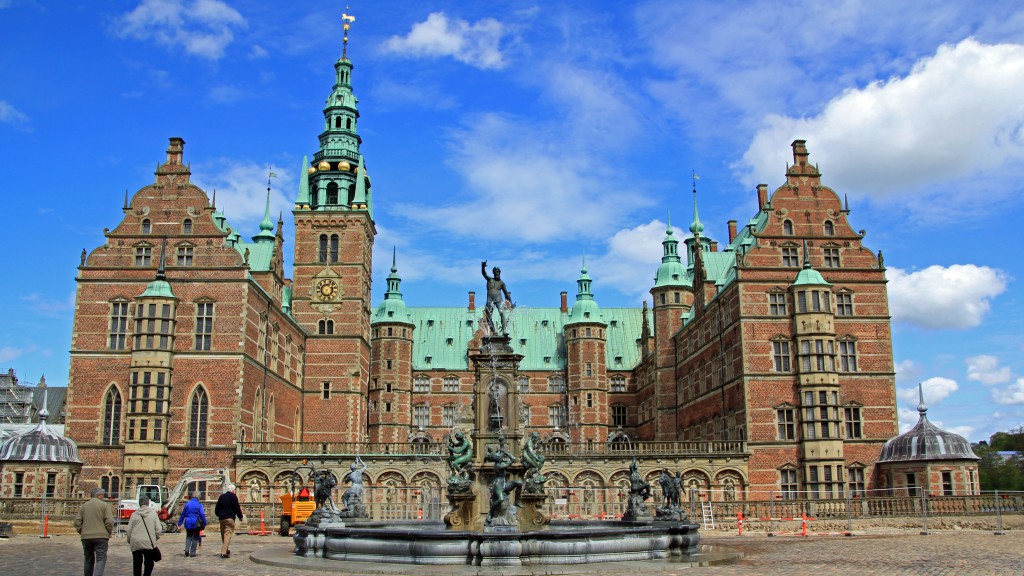
Neptune Fountain
Designed by Adrien de Vries, the Neptune fountain is considered to be the castle’s sculptural masterpiece. It was created from 1620 to 1622 to stand on the castle’s forecourt symbolizing Denmark’s position as a leading Nordic power in the early 17th century. The large bronze figures were cast in Prague where de Vries was employed as a sculptor by the imperial palace. Symbolizing the Danish king, the sea god Neptune is the central figure, while tritons piping their seashells decorate the outer basin. The current fountain is a copy of the original which was dismantled by the Swedish troops in 1659 and taken to Sweden for war reparations following the Treaty of Roskilde in 1658. The reassembled fountain now stands in the gardens of Drottningholm Palace outside Stockholm. The copy was made by Heinrich Hansen in 1888 with funding from J.C. Jacobsen.
海王星噴泉
海王星噴泉由Adrien de Vries設計,被認為是城堡的雕塑傑作。 它創建於1620年至1622年,位於城堡的前院,象徵著丹麥在17世紀初作為北歐領先大國的地位。 大型青銅人物在布拉格演出,德弗里斯被皇宮用作雕塑家。 象徵著丹麥國王,海神海王星是中心人物,而氚核管貝殼裝飾外盆。 現在的噴泉是原件的複製品,由瑞典軍隊在1659年拆除並在1658年羅斯基勒條約之後被帶到瑞典進行戰爭賠償。重新組裝的噴泉現在位於斯德哥爾摩外的Drottningholm宮的花園中。 該副本由海因里希·漢森於1888年在J.C.雅各布森的資助下製作。
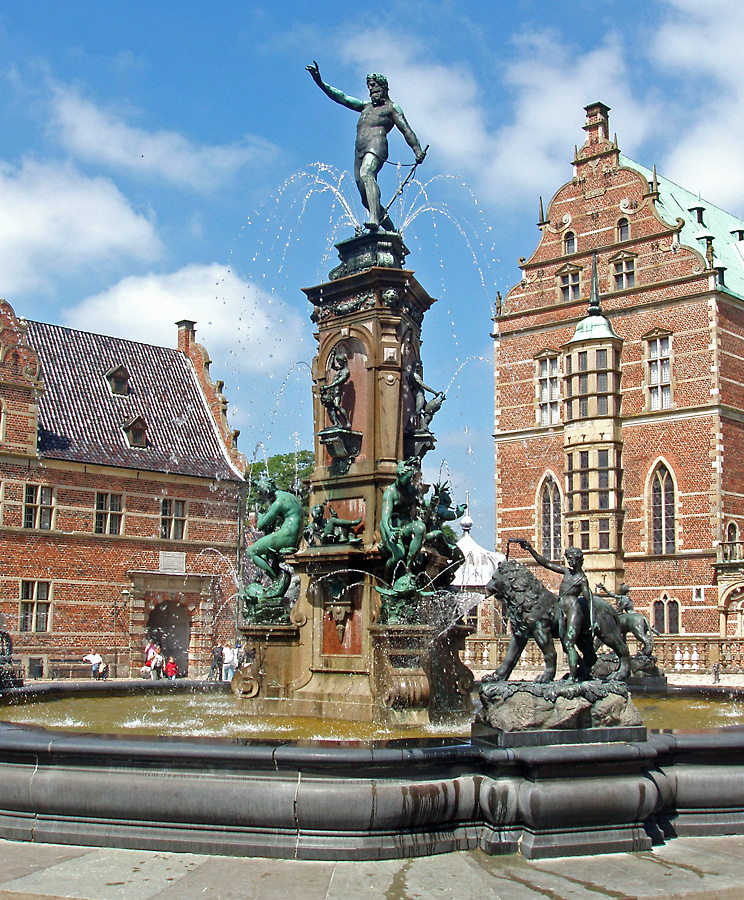
Chapel
The chapel, consecrated in 1617, is also part of the museum. It is the best preserved part of the Renaissance complex, having largely escaped damage in the 1859 fire. The chapel extends along the entire length of the west wing with a long nave and a two-storey gallery. The richly decorated six-vaulted stucco ceiling is borne by pillars rising from the galleries.
The pillars bear grisaille frescos of Biblical figures, painted in the 1690s. The galleries were decorated during the reign of Frederick III (1648–1670) as can be see from his arms.
The Chapel’s most significant artifact is the organ, built by Esajas Compenius in 1610. It was installed by Compenius himself shortly before his death in Hillerød in 1617. The oldest organ in Denmark, it has 1,001 wooden pipes. Its original manually driven blower has been preserved. The instrument is richly decorated with ebony, ivory and silver.
The altarpiece and pulpit from the early 17th century are the work of the silversmith Jacob Mores from Hamburg. In the king’s prayer chamber adjoining the Chapel, there is a small silver altar crafted by the goldsmith Matthäus Wallbaum from Augsburg in 1600.
教堂
該教堂於1617年建成,也是博物館的一部分。它是文藝復興時期建築群中保存最完好的部分,在1859年的火災中大部分都沒有受到破壞。教堂沿著西翼的整個長度延伸,有一個長長的教堂中殿和一個兩層高的畫廊。裝飾華麗的六層拱形灰泥天花板由畫廊上升的柱子承擔。
這些柱子上刻有16世紀90年代繪製的聖經人物的grisaille壁畫。畫廊在弗雷德里克三世(1648-1670)統治期間進行了裝飾,從他的手臂可以看出。
教堂最重要的文物是由Esajas Compenius於1610年建造的器官。它是由康普紐斯本人在1617年在希勒勒德去世前不久安裝的。它是丹麥最古老的器官,擁有1,001根木管。其原有的手動鼓風機已被保留。該儀器裝飾華麗,烏木,象牙色和銀色。
17世紀初的祭壇和講壇是來自漢堡的銀匠Jacob Mores的作品。在毗鄰教堂的國王祈禱室裡,有一個小銀壇由1600年奧格斯堡的金匠馬特烏斯·沃爾鮑姆(MatthäusWallbaum)製作而成。
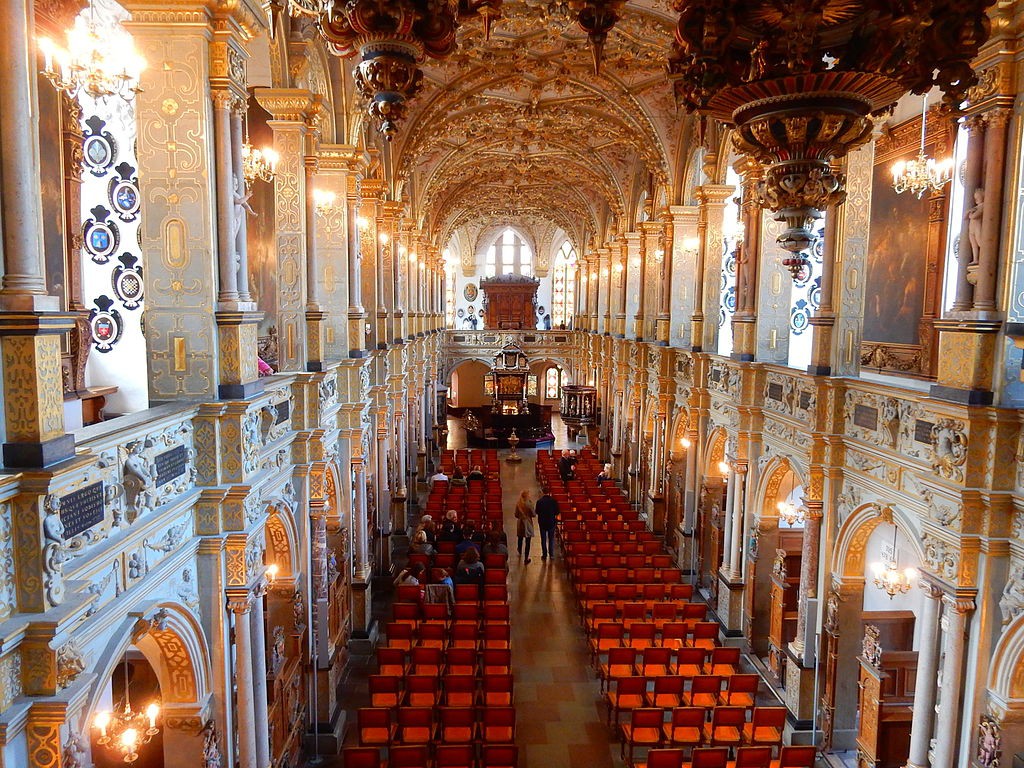
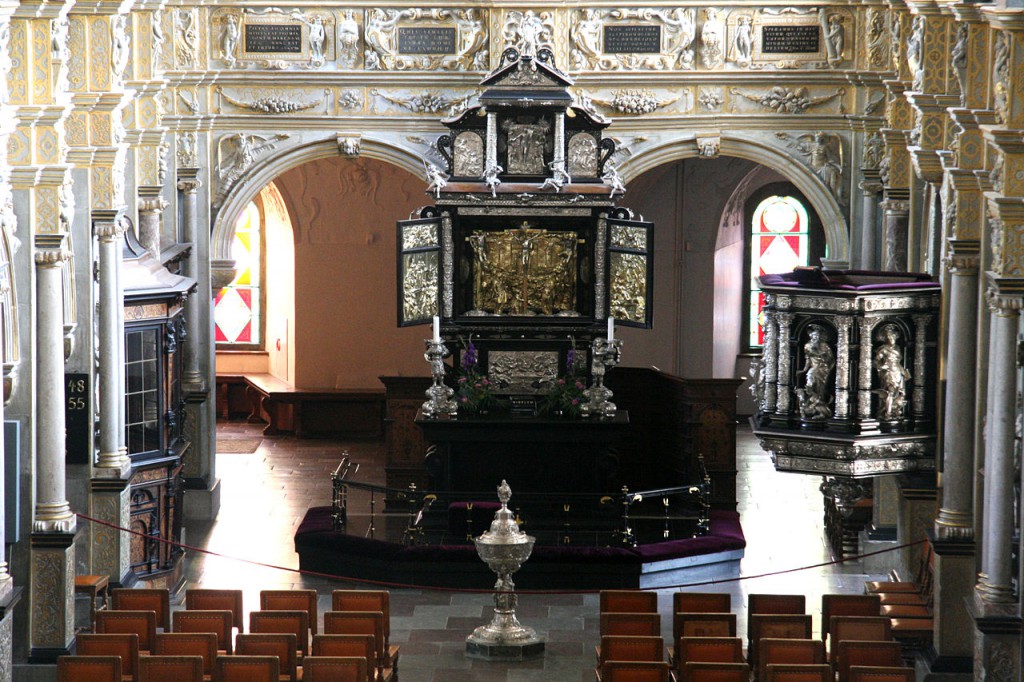
Great Hall
The Great Hall (Riddersalen) is situated above the Chapel and also extends over the length of the west wing. It was destroyed by fire in 1859 but was almost fully restored thanks to architectural paintings made by Heinrich Hansen and F.C. Lund. The restoration work, completed in 1880, was carried out by Ferdinand Meldahl who made use of preserved segments of the ornate gilded ceiling. The large chandelier in the centre of the room is the work of Meldahl’s pupil, Carl Brummer. The original tapestries depicting important events in the life of Christian IV were woven in Karel van Mander’s workshop in Delft. The copies decorating the walls of the hall today were created from Mander’s sketches.
大廳
大廳(Riddersalen)位於教堂上方,也延伸到西翼的長度。 它在1859年被火燒毀,但由於Heinrich Hansen和F.C.製作的建築畫,幾乎完全恢復了。隆德。 修復工作於1880年完成,由費迪南德梅爾達爾(Ferdinand Meldahl)完成,他利用華麗鍍金天花板的保存部分。 房間中央的大型枝形吊燈是Meldahl的學生Carl Brummer的作品。 描繪克里斯蒂安四世生活中重要事件的原始掛毯是在代爾夫特的卡雷爾範曼德工作室編織的。 今天裝飾大廳牆壁的副本是從曼德的草圖中創建的。
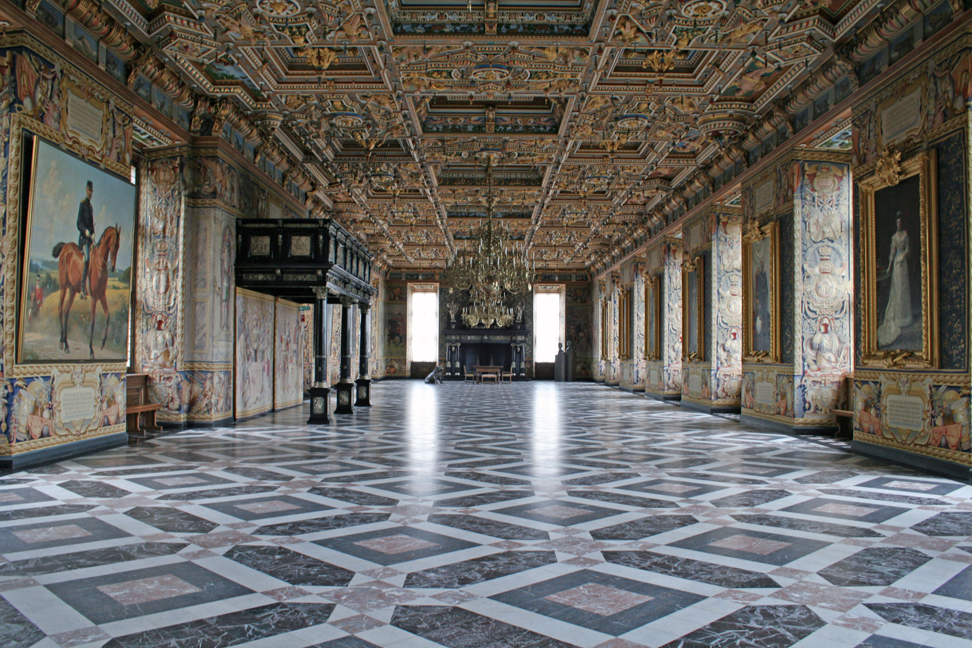
Rose Room
The room on the ground floor in the King’s Wing known as the Rose was originally a dining room for the king and his courtiers. It was also destroyed by the fire in 1859, but was reconstructed from old paintings. The two series of six vaults rest on free-standing pillars. It is thought Mehldahl managed to reuse parts of the window decorations including the monograms of Christian IV and Queen Catherine.
玫瑰廳
國王翼樓底層的房間被稱為玫瑰,最初是國王和他的朝臣的餐廳。 它也被1859年的大火摧毀,但是是用舊畫重建的。 兩個系列的六個拱頂依靠獨立的支柱。 人們認為Mehldahl設法重複使用部分窗戶裝飾品,包括Christian IV和Queen Catherine的字母組合。
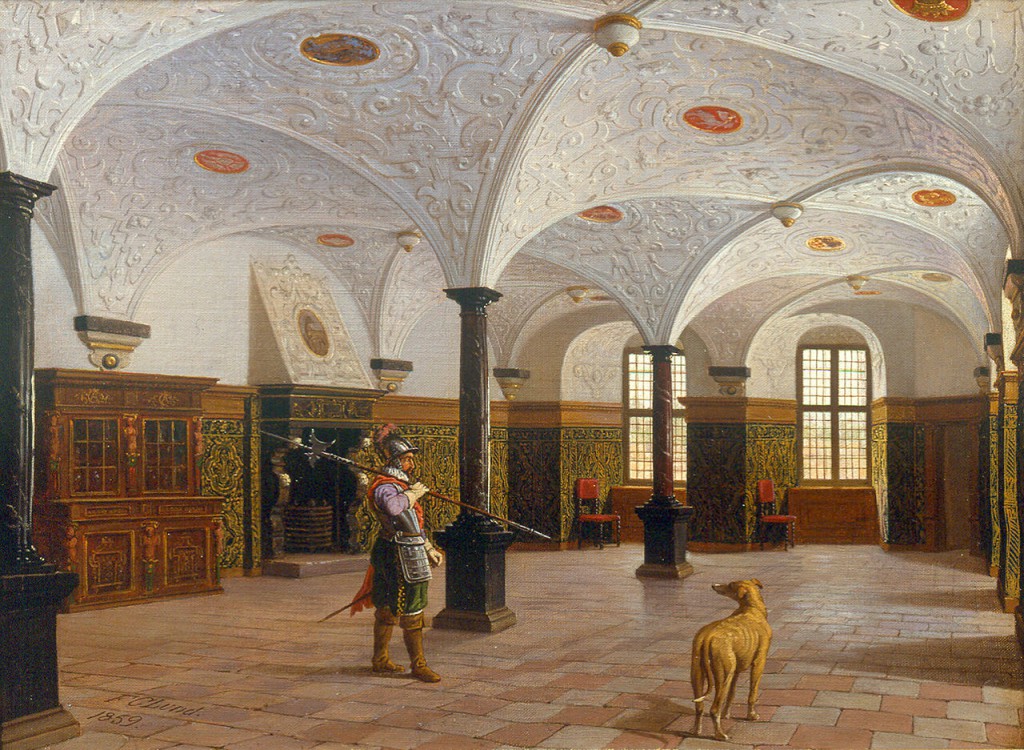
Audience Chamber
Extending into the middle islet, the Audience Chamber also escaped damage from the fire in 1859. It was decorated by Christian V’s master builder Lambert van Haven in the 1680s, combining the Renaissance style with Baroque. He had himself brought the paintings in adjoining Privy Passage (Conseilgangen) back from Italy. His work was completed in 1688, making the Audience Chamber the oldest preserved Baroque room in Denmark. The sumptuous ceiling in the Privy Passage with flowering vines, creepers and rosettes is the work of the stucco artists Jan Wilckens van Verelt and Christian Nerger. The Audience Chamber itself was completed in 1689. The chandelier with a carved deer was crafted around 1625 by Hans Ocksen. The chair in the north-east corner allowed the king to be lifted up from the building’s entrance. The central dome, designed by van Haven, bears the motto of Christian V, Pietate et Justitia (Piety and Justice) and is decorated with allegorical paintings of a Christian queen, a negro, a Turk, and an American Indian representing Europe, Africa, Asia and America. The paintings on the walls by the Christian V’s court painter Jacob d’Agar depict the kings ancestors. They are surmounted by scenes from the king’s glorious Scanian War (1675–1697) painted by Claus Møinchen and Christian Morholt, despite the fact that in the end, Denmark was defeated.
觀眾會議廳
1859年,觀眾廳延伸到中間的小島,也逃脫了火災的破壞。它由Christian V的建築師Lambert van Haven在1680年代裝飾,結合了文藝復興風格和巴洛克風格。他自己把這些畫作從意大利帶回了相鄰的Privy Passage(Conseilgangen)。他的作品於1688年完成,使Audience Chamber成為丹麥最古老的保存完好的巴洛克式房間。 Privy Passage的豪華天花板上有開花的藤蔓,藤蔓和玫瑰花結,是灰泥藝術家Jan Wilckens van Verelt和Christian Nerger的作品。觀眾廳本身於1689年完工。帶雕刻鹿的枝形吊燈由Hans Ocksen於1625年左右精心製作。東北角的椅子讓國王從建築物的入口處升起。由van Haven設計的中央穹頂飾有Christian V,Pietate et Justitia(虔誠與正義)的座右銘,並飾有基督教女王,黑人,土耳其人和代表歐洲,非洲的美洲印第安人的寓言畫作。亞洲和美國。 Christian V的宮廷畫家Jacob d’Agar在牆上畫的畫描繪了國王的祖先。他們被克勞斯·莫辛(ClausMøinchen)和克里斯蒂安·莫霍爾特(Christian Morholt)繪製的國王光榮的斯堪尼亞戰爭(1675-1697)中的場景所擊敗,儘管最終丹麥被擊敗了。

Castle parks
Baroque Park with its cascading water feature in the background
In 1850, Frederick VII had a landscaped garden laid out to the north-west of the castle with winding paths, canals and artificial lakes. On Louise’s Island, named after his third wife, a small wooden manor house was built in the Norwegian style, from which the king could go out fishing and enjoy uninterrupted breaks with his wife.
To the east of the castle, the Baroque Park with its waterfalls was originally created by the court gardener Johan Cornelius Krieger for Frederick IV in the early 1720s. Its carefully planned symmetrical features were designed to surround the parks centrepiece, a fountain from which water cascaded down the terraces to the lake below. Neatly laid out paths, shrubs and flowerbeds were arranged around the central fountain. The garden was maintained until the beginning of the 19th century when it was abandoned. The shrubs grew wild but the paths and terraces could still be seen. In 1993 it was decided to recreate the park in its original style. Now known as Kaskaderne (The Cascades), it was reopened in 1996 with a multitude of new shrubs and trees, making it Denmark’s most notable Baroque garden. Crafted in miniature hedges, the monograms of Frederick IV, Christian VI, Frederick V and Margrethe II form part of the central layout.
城堡公園
巴洛克式公園及其層疊水景在背景中
1850年,弗雷德里克七世在城堡的西北部設有一個園景花園,有蜿蜒的小徑,運河和人工湖。在以他的第三任妻子命名的路易斯島上,一座小型木製莊園以挪威風格建造,國王可以從那裡出去釣魚並與妻子一起享受不間斷的休息。
在城堡的東邊,巴洛克公園及其瀑布最初由法院園丁Johan Cornelius Krieger於1720年代早期為弗雷德里克四世創建。其精心設計的對稱特徵被設計成圍繞公園中心,噴泉從梯田到下面的湖泊。在中央噴泉周圍佈置了整齊的路徑,灌木和花壇。花園一直保持到19世紀初被遺棄的時候。灌木叢生長,但仍然可以看到路徑和梯田。 1993年,決定以原始風格重建公園。現在被稱為Kaskaderne(The Cascades),於1996年重新開放,擁有眾多新的灌木和樹木,成為丹麥最著名的巴洛克式花園。 Frederick IV,Christian VI,Frederick V和Margrethe II的字母組合在微型樹籬中,構成了中央佈局的一部分。
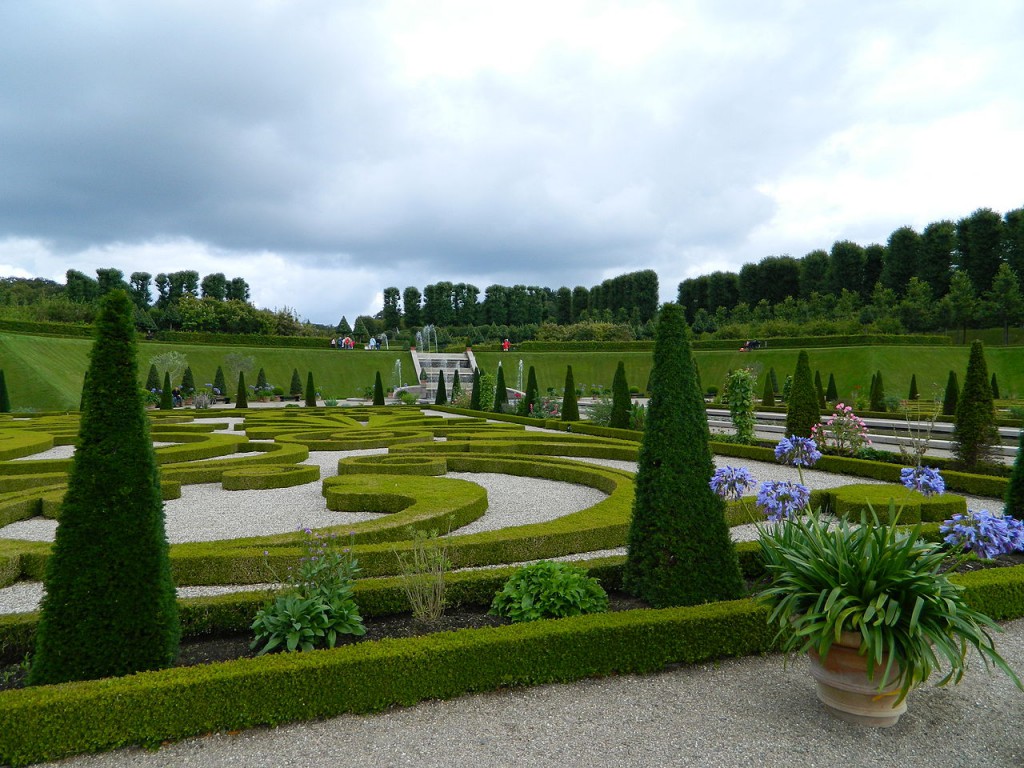
FROM:https://en.wikipedia.org/wiki/Frederiksborg_Castle
FROM:Hillerød, Denmark: Stunning Frederiksborg Castle
FROM:Frederiksborg Castle, Denmark – Aerial Drone Video (HD)
FROM:Frederiksborg Castle Copenhagen Denmark
FROM:Frederiksborg Castle and Charlottenlund Palace Phantom 4 pro drone 4K
Don’t you think it’s addictive?
Want to know more about the beauty of architecture?
Come and join our members to explore the beauty of architectural design.
覺得看得不過癮嗎?
想要知道更多建築之美嗎?
快來加入我們的會員,一同探索建築設計之美。
The above article is purely for appreciation and sharing purposes, as well as the construction of new technology and the public can be in-depth understanding of the information at the same time there are sources, will be able to query, no use of the document as a commercial transaction, if illegal, please inform the We will immediately remove the site, thank you for cooperation.
以上文章純粹作為欣賞及分享用途,以及將建築新型技術傳遞給與大眾能夠深入了解,同時資料還有來源,將可查詢,絕無使用該文件資料作為商業交易行為,如有違法請務必告知該網站我們將立即處理撤除,謝謝合作。

